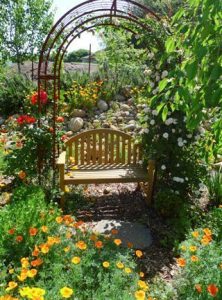If you’re perfectly happy shelling out yet more money on big flats of tender annuals like impatiens, begonias, and African daisies every single spring, even though you know they’ll turn to black mush after the first frost, this article isn’t for you. If, like me, you’d prefer to spend your money on hardy perennials that will return all by themselves year after year with relatively little tending, read on. The key to a healthy, long-lived garden that you don’t have to totally restock every year is plant selection. Here are three tips I learned the hard way:
Don’t rely on nursery plant tags. The labels that accompany nursery plants, especially at big-box stores, are often very nonspecific (“full sun to part shade”). My guess is that those overly generalized tags are simply a cost-effective way to stay in some vague range of growing advice for vast inventories of plants.
I have tried and failed more times than I can count when trusting plant tags that don’t address the specifics of my locale. For example, when those generic plant tags say “full sun,” they don’t really mean the full, blast-furnace sun we get in the Mother Lode in August. I’m convinced their guide for a “full sun” rating is based on summer in the Yukon.
That’s why I prefer to use Sunset’s Western Garden Book or UC’s California Garden Web (https://cagardenweb.ucanr.edu/) to research plants’ ideal growing conditions. For example, while a nursery plant tag might say “full sun,” Sunset, which knows California sun, is likely to say “full sun with light afternoon shade.” And that makes a big difference to plant health, in my experience.
Know your zone. Instead of relying wholly on nursery plant tags, do a little research to determine a plant’s climate zone. Generally speaking, we’re in Sunset’s Zone 7, which has hot, dry summers and typical winter lows that range from 35 to 26 degrees. But winter lows in the high-country communities drop sharply to Zone 1A, with average lows from 11 to 0 degrees. Big difference. (Note that the USDA has its own zone numbering system, which is slightly different from Sunset’s.) Once you know your zone, you can quickly rule out plants that thrive in more tropical conditions (read, no frost, let alone snow).
Buy plants that love your soil. I know, this is a radical idea. The common wisdom seems to be, buy whatever plant catches your fancy, then dig in bags of amendments in an attempt to make your soil what it’s not. But the fact is, UC research has shown that over time, amending planting holes alone does next to nothing to change, say, heavy clay soil. It will revert to its natural state.
The better approach is to select plants that either thrive in, or are not bothered by our rocky clay soil. Believe me, there’s no shortage of beautiful, hardy perennials to choose from: black-eyed Susan, Russian sage, daylily, coneflower, Shasta daisy, yarrow, switch grass, salvia and any foothills native, to name a few.
So, this spring, if you’d like to dig less, spend less, and witness the annual magic of perennials reemerging with little help from you, make savvy plant choices for your garden.
Rachel Oppedahl is a University of California Cooperative Extension Master Gardener of Tuolumne County.

